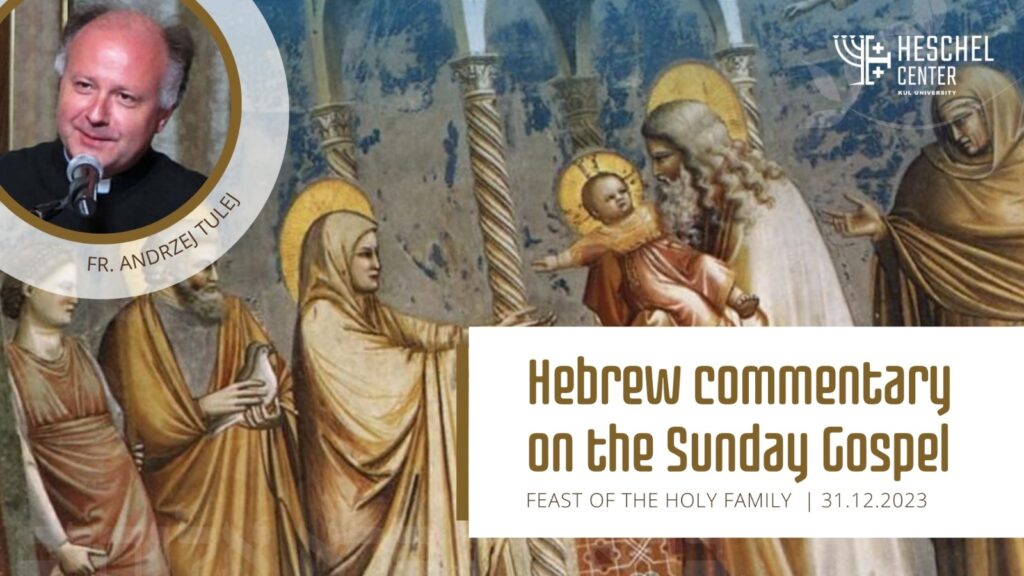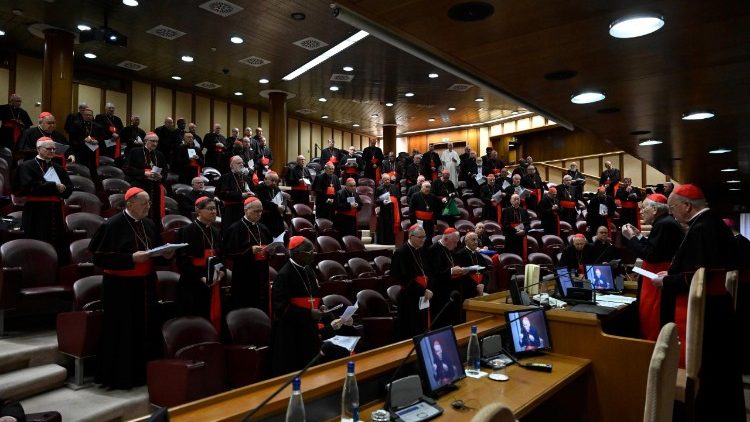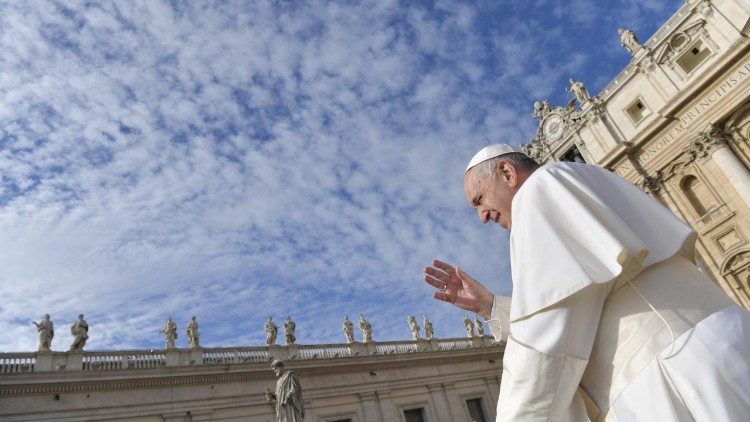Heschel Centre for Catholic-Jewish Relations at the Catholic University of Lublin
01 January, 2024
7 min
Three Mysteries of the Fortieth Day After the Birth of Jesus
On the fortieth day after the birth of a son, according to Jewish Law, three events took place: the “purification” of the child’s mother, the “redemption” of the firstborn, and the “presentation” of the child. Luke does not mention the redemption of Jesus. He goes straight to the “presentation” (entrustment) of Jesus as if he […]

On the fortieth day after the birth of a son, according to Jewish Law, three events took place: the “purification” of the child’s mother, the “redemption” of the firstborn, and the “presentation” of the child. Luke does not mention the redemption of Jesus. He goes straight to the “presentation” (entrustment) of Jesus as if he wanted to say that Jesus was not redeemed and not returned to His parents. On the contrary: he was given to God his Father in the Temple, for his complete ownership,” stressed Fr. Dr. Andrzej Tulej, lecturer in Sacred Scripture at the Catholic Academy in Warsaw, in a commentary for the Heschel Center of the Catholic University of Lublin, for Holy Family Sunday.
The complete text of the commentary follows:
“When the days were completed for their purification according to the law of Moses, they took him up to Jerusalem to present him to the Lord, just as it is written in the law of the Lord, “Every male that opens the womb shall be consecrated to the Lord,’ and to offer the sacrifice of ‘a pair of turtledoves or two young pigeons,’ in accordance with the dictate in the Law of the Lord.” (Lk 2:22-24)
Yeshua – Yahweh is salvation
This is the beginning of the Gospel read on Holy Family Sunday. It is preceded by another essential message not included in the lectionary: “When eight days were completed for his circumcision, he was named Jesus, the name given him by the angel before he was conceived in the womb” (Lk 2:21).
Thus, first, Joseph and Mary took care that the Child entrusted to them was circumcised following the Mosaic Law: “Throughout the ages, every male among you, when he is eight days old, shall be circumcised” (Gen 17:12); “On the eighth day, the flesh of the boy’s foreskin shall be circumcised” (Lev 12:3).
This act incorporates Jesus into the community of Abraham’s descendants and obligates him to fulfill the Law and be faithful to the covenant. At the same time, the child is to receive a name. In this case, the name was suggested earlier by the Angel Gabriel during the Annunciation, when he said to Mary: “Behold, you will conceive in your womb and bear a son, and you shall name him Jesus” (Lk 1:31). God Himself wants the name of His incarnate Son – Hebrew Yeshua (Yahweh is salvation) – to unequivocally point to His salvific mission, which Luke emphasizes more than the other evangelists throughout his work.
Three mysteries of the fortieth day after the birth of the son
Three events are associated with the fortieth day: Mary’s “purification,” the “redemption” of the firstborn child Jesus, and the “presentation” of Him in the Temple.
Purification
According to the Mosaic Law, a woman would enter a state of ritual impurity after giving birth. According to Leviticus 12:4-5, the whole time of uncleanness lasts 40 days in the case of giving birth to a son and 80 days in the case of giving birth to a girl, and then the woman had to avoid contact with holy things and could not enter the Temple: “Then she shall spend thirty-three days more in a state of blood purity; she shall not touch anything sacred nor enter the sanctuary till the days of her purification are fulfilled. If she gives birth to a girl, for fourteen days, she shall be as unclean as during her menstrual period, after which she shall spend sixty-six days in a state of blood purity”.
At the end of these days, a burnt offering of a one-year-old lamb and a purification offering of a young pigeon or turtledove was to be offered in the Temple: “When the days of her purification for a son or for a daughter are fulfilled, she shall bring to the priest at the entrance of the tent of meeting a yearling lamb for a burnt offering and a pigeon or a turtledove for a purification offering” (Lev 12:6). Poor families who could not afford to sacrifice a lamb were required to offer at least two turtledoves or two young pigeons – one for a burnt offering and the other for a purification offering: “If, however, she cannot afford a lamb, she may take two turtledoves or two pigeons,e the one for a burnt offering and the other for a purification offering. The priest shall make atonement for her, and thus she will again be clean” (Lev 12:8).
By mentioning in the Gospel text a pair of turtledoves or two young pigeons, Luke makes it clear that Mary and Joseph are a poor family and that the whole event is not just about removing the ritual impurity caused by childbirth but about the purification that brings a person from a state of impurity to a state of holiness. Hence the plural: “When the days were completed for their purification…” (Lk 2:22), regarding both Mary and Jesus. Jesus, too, must be purified from everything that makes Him unclean in contact with the world, i.e., from what distances Him from God, since He is to be “consecrated to the Lord.”
The unmentioned redemption
The second event was the redemption of the firstborn, who was the absolute property of God. The redemption price was five shekels of silver and could be paid throughout the country by giving it to any priest: “For the redemption price of a son, when he is a month old, you shall pay the equivalent of five silver shekels according to the sanctuary shekel, that is, twenty gerahs” (Num18:16). Every first fruit of the fields, animals and people is God’s property and must be sacrificed to Him, an act of faith that it is God Himself who watches over the future of the entire world and the chosen people. However, since it is forbidden to kill people and, therefore, to sacrifice them, the institution of redemption was established. The Gospel text does not quote Exod 13:2 exactly: “Consecrate to me every firstborn; whatever opens the womb among the Israelites, a whether of human being or beast, belongs to me,” but gives a modified version: “Every male that opens the womb shall be consecrated to the Lord” (Lk 2:23). In such a context, the sacrifice offered by Mary and Joseph, which at first glance was a purification offering after childbirth, appears as a purification offering of a Nazirite, who by his vocation is a man consecrated to God and, having contracted ritual impurity, is obligated to offer the sacrifice of two turtledoves or two young pigeons to make atonement, regain his state of cultic purity and continue to serve the Lord with his life.
The offering of Jesus to God, his Father
Luke, however, says nothing about the redemption of Jesus. He goes straight to the third event, the “presentation” (entrusting) of Jesus, as if to say: this Child is not redeemed and not returned to His parents, but on the contrary, He is personally handed over to God in the Temple, for His complete ownership. The Greek word paristánai means both “to present” and “to offer” – that is, to do the same thing done with the sacrifices offered in the Temple.
None of those above acts prescribed by the Law required appearing in the Temple. For Luke, however, this first bringing of Jesus to the Temple is significant. Here, in the place where God meets His people – instead of the act of redemption of the firstborn – the public offering of Jesus to God, His Father, is made.
About the author
Fr. Dr. Andrzej Tulej – lecturer in Holy Scripture and director of blended-learning studies at the Catholic Academy in Warsaw, consultant to the Council for Ecumenism of the Polish Bishops’ Conference, delegate for dialogue with Judaism and ecumenism and interreligious contacts of the Warsaw archdiocese, moderator of the St. John Paul II Bible Work of the Warsaw archdiocese, rector of the Church of St. Casimir the King and chaplain of the Benedictine Sisters of the Blessed Sacrament in Warsaw. He has published, among other books, The Second Vatican Council on Jews and Judaism. A history of the origin of the “Nostra Aetate 4” text.
Related

What are the Congregations before the Conclave?
Exaudi Staff
29 April, 2025
3 min

Carlo Acutis: The Cyber-Apostle of the Eucharist Who Inspires Youth
Exaudi Staff
29 April, 2025
4 min

Miserando atque eligendo: The Legacy of Mercy in the Church
Luis Herrera Campo
28 April, 2025
3 min

A Meeting of Hope in St. Peter’s Basilica: Trump and Zelensky
Exaudi Staff
27 April, 2025
2 min
 (EN)
(EN)
 (ES)
(ES)
 (IT)
(IT)

